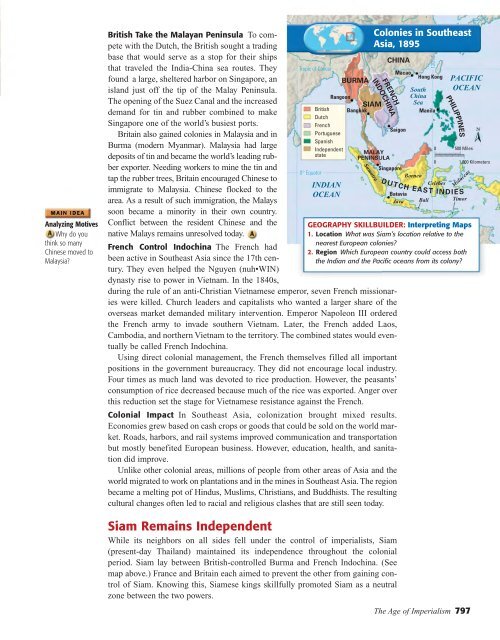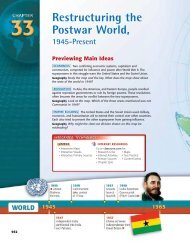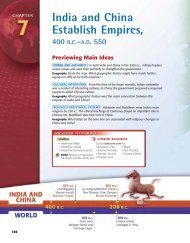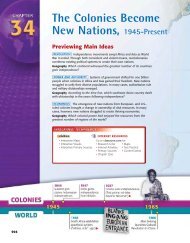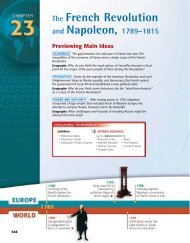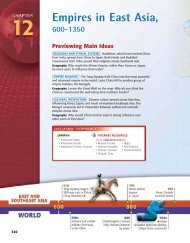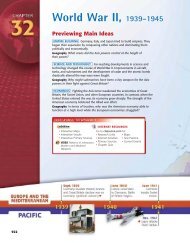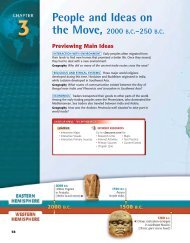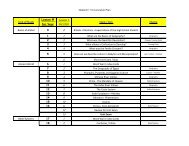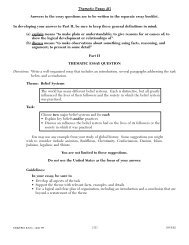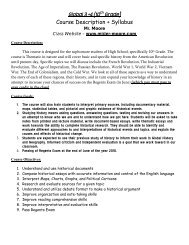The Age of Imperialism, - First
The Age of Imperialism, - First
The Age of Imperialism, - First
You also want an ePaper? Increase the reach of your titles
YUMPU automatically turns print PDFs into web optimized ePapers that Google loves.
Analyzing Motives<br />
Why do you<br />
think so many<br />
Chinese moved to<br />
Malaysia?<br />
British Take the Malayan Peninsula To compete<br />
with the Dutch, the British sought a trading<br />
base that would serve as a stop for their ships<br />
that traveled the India-China sea routes. <strong>The</strong>y<br />
found a large, sheltered harbor on Singapore, an<br />
island just <strong>of</strong>f the tip <strong>of</strong> the Malay Peninsula.<br />
<strong>The</strong> opening <strong>of</strong> the Suez Canal and the increased<br />
demand for tin and rubber combined to make<br />
Singapore one <strong>of</strong> the world’s busiest ports.<br />
Britain also gained colonies in Malaysia and in<br />
Burma (modern Myanmar). Malaysia had large<br />
deposits <strong>of</strong> tin and became the world’s leading rubber<br />
exporter. Needing workers to mine the tin and<br />
tap the rubber trees, Britain encouraged Chinese to<br />
immigrate to Malaysia. Chinese flocked to the<br />
area. As a result <strong>of</strong> such immigration, the Malays<br />
soon became a minority in their own country.<br />
Conflict between the resident Chinese and the<br />
native Malays remains unresolved today.<br />
Tropic <strong>of</strong> Cancer<br />
0° Equator<br />
INDIAN<br />
OCEAN<br />
BURMA<br />
INDOCHINA<br />
French Control Indochina <strong>The</strong> French had<br />
been active in Southeast Asia since the 17th century.<br />
<strong>The</strong>y even helped the Nguyen (nuh•WIN)<br />
dynasty rise to power in Vietnam. In the 1840s,<br />
during the rule <strong>of</strong> an anti-Christian Vietnamese emperor, seven French missionaries<br />
were killed. Church leaders and capitalists who wanted a larger share <strong>of</strong> the<br />
overseas market demanded military intervention. Emperor Napoleon III ordered<br />
the French army to invade southern Vietnam. Later, the French added Laos,<br />
Cambodia, and northern Vietnam to the territory. <strong>The</strong> combined states would eventually<br />
be called French Indochina.<br />
Using direct colonial management, the French themselves filled all important<br />
positions in the government bureaucracy. <strong>The</strong>y did not encourage local industry.<br />
Four times as much land was devoted to rice production. However, the peasants’<br />
consumption <strong>of</strong> rice decreased because much <strong>of</strong> the rice was exported. Anger over<br />
this reduction set the stage for Vietnamese resistance against the French.<br />
Colonial Impact In Southeast Asia, colonization brought mixed results.<br />
Economies grew based on cash crops or goods that could be sold on the world market.<br />
Roads, harbors, and rail systems improved communication and transportation<br />
but mostly benefited European business. However, education, health, and sanitation<br />
did improve.<br />
Unlike other colonial areas, millions <strong>of</strong> people from other areas <strong>of</strong> Asia and the<br />
world migrated to work on plantations and in the mines in Southeast Asia. <strong>The</strong> region<br />
became a melting pot <strong>of</strong> Hindus, Muslims, Christians, and Buddhists. <strong>The</strong> resulting<br />
cultural changes <strong>of</strong>ten led to racial and religious clashes that are still seen today.<br />
Siam Remains Independent<br />
While its neighbors on all sides fell under the control <strong>of</strong> imperialists, Siam<br />
(present-day Thailand) maintained its independence throughout the colonial<br />
period. Siam lay between British-controlled Burma and French Indochina. (See<br />
map above.) France and Britain each aimed to prevent the other from gaining control<br />
<strong>of</strong> Siam. Knowing this, Siamese kings skillfully promoted Siam as a neutral<br />
zone between the two powers.<br />
FRENCH<br />
Rangoon<br />
SIAM<br />
British Bangkok<br />
Dutch<br />
French<br />
Portuguese<br />
Spanish<br />
Independent<br />
state<br />
MALAY<br />
PENINSULA<br />
Sumatra<br />
Colonies in Southeast<br />
Asia, 1895<br />
CHINA<br />
Macao<br />
Saigon<br />
South<br />
China<br />
Sea<br />
Manila<br />
Singapore<br />
Borneo<br />
DUTCH EAST INDIES<br />
Batavia<br />
Java<br />
Hong Kong<br />
Bali<br />
120° E<br />
Celebes<br />
PACIFIC<br />
OCEAN<br />
PHILIPPINES<br />
0 500 Miles<br />
0 1,000 Kilometers<br />
Moluccas<br />
Timor<br />
GEOGRAPHY SKILLBUILDER: Interpreting Maps<br />
1. Location What was Siam’s location relative to the<br />
nearest European colonies?<br />
2. Region Which European country could access both<br />
the Indian and the Pacific oceans from its colony?<br />
<strong>The</strong> <strong>Age</strong> <strong>of</strong> <strong>Imperialism</strong> 797


